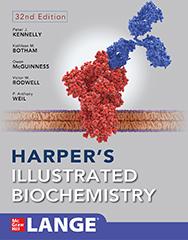Gain a thorough understanding of the principles of biochemistry as they relate to clinical medicine
The thirty-second edition of Harper's Illustrated Biochemistry combines top-quality, full-color illustrations with authoritative, integrated coverage of biochemical disease and clinical information. Featuring numerous medically relevant examples, this respected text presents a clear, succinct review of the fundamentals that every student must understand in order to succeed in medical school.
All 58 chapters help you understand the medical relevance of biochemistry.
• Full-color presentation with 600+ illustrations
• Chapters have been updated to reflect the latest information
• Case studies emphasize the clinical relevance of biochemistry
• Review questions follow each of the 11 sections
• Boxed objectives define the goals of each chapter
• Tables encapsulate important information
• Each chapter contains a section on biomedical importance and a summary of the topics covered
Applauded by medical students for its current and engaging style, Harper's Illustrated Biochemistry is an essential for USMLE review and the single best reference for learning the clinical relevance of any biochemistry topic.










